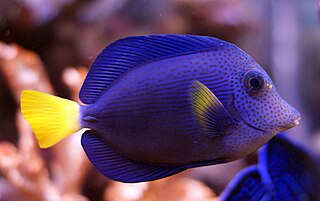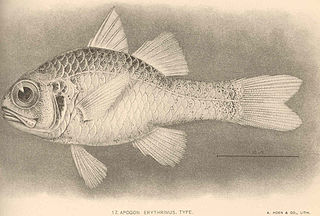
The barred conger is a species of conger eel that lives in the tropical western and central Indo-Pacific region. It is also known as the barred sand conger. It is a bottom-dwelling fish and is found in the waters around Madagascar, Indonesia, the Marshall Islands, Hawaii and Tahiti and some other island groups.

The Hawaiian grouper, also known as the Hawaiian black grouper, Seale's grouper or Hapuʻupuʻu, is a species of marine ray-finned fish, a grouper from the subfamily Epinephelinae which is part of the family Serranidae, which also includes the anthias and sea basses. It is endemic to Hawaii.

Kuhlia xenura, the strange-tailed flagtail or Hawaii flagtail, is a species of ray-finned fish, a flagtail from the family Kuhliidae which is endemic to Hawaii, where it occurs in fresh, brackish, and marine waters. It can be found in tide pools, estuaries, and on reefs occurring over sand or rock.

Salarias fasciatus, commonly known as the jewelled blenny or lawnmower blenny is a benthic, neritic, marine fish species endemic to Australasia. Despite being known as the lawnmower blenny, due to its propensity to consume algae growth in aquaria, it is principally a detritivore, with plant material making up only about 15% of its diet. The lawnmower blenny camoflauges with its surroundings, even changing color to hide itself from predators.

Zebrasoma xanthurum, the purple tang or yellowtail tang, is a species of marine ray-finned fish belonging to the family Acanthuridae which includes the surgeonfishes, unicornfishes and tangs. This species is endemic to the north western Indian Ocean.

Kuhlia sandvicensis, the reticulated flagtail, zebra-headed flagtail or Hawaiian flagtail, is a species of ray-finned fish, a flagtail from the family Kuhliidae which is found in the central Pacific Ocean. It is popular as a game fish and can also be found in the aquarium trade.

The belted cardinalfish is a tropical marine fish in the genus Apogon. They grow up to 6.5 centimetres (2.6 in) in length. Belted cardinalfish are found in the waters of the western Atlantic Ocean, off Central and South America, inhabiting caves and holes. They are pinkish-red on the dorsal side and yellowish-red on the ventral side. Their eggs are carried in the mouth of the adult as they mature.

The pebbled butterflyfish is a species of marine fish, a butterflyfish from the family Chaetodontidae. It is often found near reefs. They are at most 12 centimetres (4.7 in) in length, and white with yellow, brown, and black markings. These butterflyfish are territorial and form pairs. The pebbled butterflyfish occur near reefs in the eastern central Pacific, and are endemic to waters off the Hawaiian Islands and Johnston Atoll. They have a role in aquarium trade.

Salarias sinuosus, known commonly as the fringelip blenny or the crinkle-lipped blenny, is a species of combtooth blenny found in coral reefs in the Indian Ocean. This species reaches a length of 6 centimetres (2.4 in) TL.

Ostorhinchus neotes, the mini cardinalfish, is a species of ray-finned fish, a cardinalfish, from the family Apogonidae. It is found in the western central Pacific Ocean from the Philippines south to Australia and has been reported from Tonga. It is a small cardinalfish with a small semi-transparent body which has a black stripe along its flanks underneath the skin, and a large, black spot at the base of the caudal fin. It occurs in lagoons and outer reefs where the water is relatively clear and normally where there are soft corals or gorgonian fans. It forms small schools, but mates in couples and the male mouth broods the eggs. It shelters in crevices in the reef.
Pseudamiops is a genus of cardinalfishes native to the Pacific and Indian oceans.
Trichonotus arabicus, the Arabian sand diver, is a shallow-water, marine perciform fish in the family Trichonotidae. It is native to the western Indian Ocean, the Gulf of Oman and the Persian Gulf.

Chlorurus spilurus, known commonly as the Pacific daisy parrotfish or Pacific bullethead parrotfish and in Hawaiian called uhu, is a species of marine fish in the family Scaridae. The Pacific daisy parrotfish is widespread throughout the tropical waters of the Pacific.
Antennatus drombus is a fish of the family Antennariidae, found in the Hawaiian Islands. It grows to 12 cm (4.7 in) in total length.
Verulux solmaculata, the sunspot cardinalfish, is a species of ray-finned fish from the cardinalfish family Apogonidae. It was first described in 2016 and it occurs in the Timor Sea off New Guinea and northern Western Australia. It is a small, almost transparent cardinalfish which has three black stripes on the anterior part of the body one from the tip of the snout to the front of the eye, one from the preopercular margin to the middle of the operculum, and one from the back edge of the eye to the angle of the preoperculum. It can be distinguished from its only congener, Verulux cypselurus, by there being an obvious black blotch at the base of the caudal fin, while this is lacking in V. cypselurus, and in having a, a broader black longitudinal band on each caudal fin lobe which covers 3–5 rays in this species as compared to 1–3 rays in V. cypselurus. This species also has a photophore below the posterior edge of the gill opening.

Craterocephalus eyresii, the Lake Eyre hardyhead, is a species of freshwater silverside from the family Atherinidae which is endemic to the Lake Eyre basin in Australia.

Cirrhitops mascarenensis is a species of marine ray-finned fish, a hawkfish belonging to the family Cirrhitidae. It is found in the southwestern Indian Ocean.

Apogon erythrinus, also called Hawaiian ruby cardinalfish, is a marine fish species endemic to Hawaii. It belongs to the family Apogonidae and the subfamily Apogoninae.
Chromis verater, commonly known as threespot chromis, is a species of damselfish endemic to Hawaii. The species is planktivorous.
Pycnochromis hanui, commonly known as chocolate-dip chromis, is a species of damselfish endemic to Hawaii.













